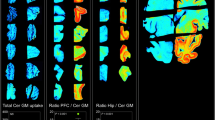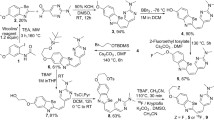Abstract
Amyloid plaques are highly heterogeneous in content, size, density, and macromolecular crowding, as they are composed of masses of fibrils and other cellular material. Given this target architecture, the aggregated microenvironment offers a unique imaging target for ligands and positron emission tomography (PET) molecular imaging probes (MIPs). In this work, we address how the heterogeneous microenvironment of a plaque and its evolution may affect the kinetic rate constant of PET MIPs. We argue that macromolecular crowding will result in anomalous diffusion within plaque regions. To account for anomalous diffusion within plaques, we propose a diffusion-limited ligand-receptor compartmental model. Given the current state of knowledge about the pathological progression of Alzheimer's disease (AD), the model's parameters may be a function of the pathological progression of AD, which could result in biased estimates of the true amyloid load. The bias may be partially overcome through evaluation in conjunction with other measures of AD progression including cerebral glucose metabolism rate, neuronal cell loss, and activated inflammatory presence.









Similar content being viewed by others
References
Shoghi-Jadid K, Barrio JR, Kepe V, et al. (2005) Imaging beta-amyloid fibrils in Alzheimer's disease: A critical analysis through simulation of amyloid fibril polymerization. Nucl Med Biol 32(4): 337–351
Shen C-L, Murphy R (1995) Solvent effects on self-assembly of beta-amyloid peptide. Biophys J 69:640–651
Trojanowski JQ, Shin RW, Schmidt ML, et al. (1995) Relationship between plaques, tangles, and dystrophic processes in Alzheimer's disease. Neurobiol Aging 16(3):335–340; discussion 341–345
Yen SH, Liu WK, Hall FL, et al. (1995) Alzheimer neurofibrillary lesions: Molecular nature and potential roles of different components. Neurobiol Aging 16(3):381–387
Mackenzie IR, Hao C, Munoz DG (1995) Role of microglia in senile plaque formation. Neurobiol Aging 16(5):797–804
Yamaguchi H, Nakazato Y, Shoji M, et al. (1991) Ultrastructure of diffuse plaques in senile dementia of the Alzheimer type: Comparison with primitive plaques. Acta Neuropathol (Berl) 82(1):13–20
Griffin WS, Sheng JG, Mrak RE (1997) Inflammatory pathways. In: Wasco W, Tanzi RE (eds) Molecular mechanisms of dementia. pp. 196–176
Hyman BT, Marzloff K, Arriagada PV (1993) The lack of accumulation of senile plaques or amyloid burden in Alzheimer's disease suggests a dynamic balance between amyloid deposition and resolution. J Neuropathol Exp Neurol 52(6):594–600
Arriagada PV, Growdon JH, Hedley-Whyte ET, et al. (1992) Neurofibrillary tangles but not senile plaques parallel duration and severity of Alzheimer's disease. Neurology 42(3 Pt 1):631–639
Berg L, McKeel DW Jr, Miller JP, et al. (1993) Neuropathological indexes of Alzheimer's disease in demented and nondemented persons aged 80 years and older. Arch Neurol 50(4):349–358
Thal DR, Rub U, Schultz C, et al. (2000) Sequence of Abeta-protein deposition in the human medial temporal lobe. J Neuropathol Exp Neurol 59(8):733–748
Kato S, Gondo T, Hoshii Y, et al. (1998) Confocal observation of senile plaques in Alzheimer's disease: Senile plaque morphology and relationship between senile plaques and astrocytes. Pathol Int 48(5):332–340
Hyman BT, West HL, Rebeck GW, et al. (1995) Quantitative analysis of senile plaques in Alzheimer disease: Observation of log-normal size distribution and molecular epidemiology of differences associated with apolipoprotein E genotype and trisomy 21 (Down syndrome). Proc Natl Acad Sci U S A 92(8):3586–3590
Stauffer D (1994) Introduction to percolation theory. CRC Boca Raton: Press
Sahimi M (1994) Applications of percolation theory. CRC Boca Raton: Press
Saxton MJ (1994) Anomalous diffusion due to obstacles: A Monte Carlo study. Biophys J 66(2 Pt 1):394–401
Saxton MJ (1996) Anomalous diffusion due to binding: A Monte Carlo study. Biophys J 70(3):1250–1262
Berry H (2002) Monte Carlo simulations of enzyme reactions in two dimensions: Fractal kinetics and spatial segregation. Biophys J 83(4):1891–1901
Urbanc B, Cruz L, Buldyrev SV, et al. (1999) Dynamics of plaque formation in Alzheimer's disease. Biophys J 76(3):1330–1334
Nakayama H, Kiatipattanasakul W, Nakamura S, et al. (2001) Fractal analysis of senile plaque observed in various animal species. Neurosci Lett 297(3):195–198
Arnold SE, Hyman BT, Flory J, et al. (1991) The topographical and neuroanatomical distribution of neurofibrillary tangles and neuritic plaques in the cerebral cortex of patients with Alzheimer's disease. Cereb Cortex 1(1):103–116
Braak H, Braak E (1991) Neuropathological stageing of Alzheimer-related changes. Acta Neuropathol (Berl) 82(4):239–259
Braak H, Braak E (1997) Frequency of stages of Alzheimer-related lesions in different age categories. Neurobiol Aging 18(4):351–357
Price JL, Davis PB, Morris JC, et al. (1991) The distribution of tangles, plaques and related immunohistochemical markers in healthy aging and Alzheimer's disease. Neurobiol Aging 12(4):295–312
Bruce CV, Clinton J, Gentleman SM, et al. (1992) Quantifying the pattern of beta/A4 amyloid protein distribution in Alzheimer's disease by image analysis. Neuropathol Appl Neurobiol 18(2):125–136
Jellinger KA (1998) The neuropathological diagnosis of Alzheimer disease. J Neural Transm Suppl 53:97–118
Braak H, Braak E (1991) Demonstration of amyloid deposits and neurofibrillary changes in whole brain sections. Brain Pathol 1(3):213–216
Miyawaki K, Nakayama H, Matsuno S, et al. (2002) Three-dimensional and fractal analyses of assemblies of amyloid beta protein subtypes [Abeta40 and Abeta42(43)] in canine senile plaques. Acta Neuropathol (Berl) 103(3):228–236
Naslund J, Haroutunian V, Mohs R, et al. (2000) Correlation between elevated levels of amyloid beta-peptide in the brain and cognitive decline. JAMA 283(12):1571–1577
Mueggler T, Meyer-Luehmann M, Rausch M, et al. (2004) Restricted diffusion in the brain of transgenic mice with cerebral amyloidosis. Eur J Neurosci 20(3):811–817
Bacskai BJ, Hickey GA, Skoch J, et al. (2003) Four-dimensional multiphoton imaging of brain entry, amyloid binding, and clearance of an amyloid-beta ligand in transgenic mice. Proc Natl Acad Sci U S A 100(21):12462–12467
Reilly JF, Games D, Rydel RE, et al. (2003) Amyloid deposition in the hippocampus and entorhinal cortex: Quantitative analysis of a transgenic mouse model. Proc Natl Acad Sci U S A 100(8):4837–4842
Zeeberg BR, Wagner HN Jr (1987) Analysis of three- and four-compartment models for in vivo radioligand–neuroreceptor interaction. Bull Math Biol 49(4):469–486
Cagnin A, Brooks DJ, Kennedy AM, et al. (2001) In-vivo measurement of activated microglia in dementia. Lancet 358(9280):461–467
Cagnin A, Gerhard A, Banati RB (2002) In vivo imaging of neuroinflammation. Eur Neuropsychopharmacol 12(6):581–586
Frautschy SA, Cole GM, Baird A (1992) Phagocytosis and deposition of vascular beta-amyloid in rat brains injected with Alzheimer beta-amyloid. Am J Pathol 140(6):1389–1399
Tomozawa Y, Inoue T, Takahashi M, et al. (1996) Apoptosis of cultured microglia by the deprivation of macrophage colony-stimulating factor. Neurosci Res 25(1):7–15
Du Yan S, Zhu H, Fu J, et al. (1997) Amyloid-beta peptide-receptor for advanced glycation end product interaction elicits neuronal expression of macrophage-colony stimulating factor: A proinflammatory pathway in Alzheimer disease. Proc Natl Acad Sci U S A 94(10):5296–5301
Terry RD, Wisniewski HM (1975) Structural and chemical changes of the aged human brain. Psychopharmacol Bull 11(4):46
Rogers J, Lue LF (2001) Microglial chemotaxis, activation, and phagocytosis of amyloid beta-peptide as linked phenomena in Alzheimer's disease. Neurochem Int 39(5–6):333–340
Guenette SY (2003) Astrocytes: A cellular player in Abeta clearance and degradation. Trends Mol Med 9(7):279–280
Wegiel J, Wang KC, Tarnawski M, et al. (2000) Microglia cells are the driving force in fibrillar plaque formation, whereas astrocytes are a leading factor in plague degradation. Acta Neuropathol (Berl) 100(4):356–364
Blasko I, Stampfer-Kountchev M, Robatscher P, et al. (2004) How chronic inflammation can affect the brain and support the development of Alzheimer's disease in old age: The role of microglia and astrocytes. Aging Cell 3(4):169–176
Akiyama H, Barger S, Barnum S, et al. (2000) Inflammation and Alzheimer's disease. Neurobiol Aging 21(3):383–421
Giulian D, Li J, Bartel S, et al. (1995) Cell surface morphology identifies microglia as a distinct class of mononuclear phagocyte. J Neurosci 15(11):7712–7726
Giulian D, Haverkamp LJ, Li J, et al. (1995) Senile plaques stimulate microglia to release a neurotoxin found in Alzheimer brain. Neurochem Int 27(1):119–137
Itagaki S, McGeer PL, Akiyama H, et al. (1989) Relationship of microglia and astrocytes to amyloid deposits of Alzheimer disease. J Neuroimmunol 24(3):173–182
Rozemuller JM, Bots GT, Roos RA, et al. (1992) Acute phase proteins but not activated microglial cells are present in parenchymal beta/A4 deposits in the brains of patients with hereditary cerebral hemorrhage with amyloidosis-Dutch type. Neurosci Lett 140(2):137–140
Small GW, Ercoli LM, Silverman DH, et al. (2000) Cerebral metabolic and cognitive decline in persons at genetic risk for Alzheimer's disease. Proc Natl Acad Sci USA 97(11):6037–6042
Silverman DH, Small GW, Phelps ME (1999) Clinical value of neuroimaging in the diagnosis of dementia. Sensitivity and specificity of regional cerebral metabolic and other parameters for early identification of Alzheimer's disease. Clin Positron Imaging 2(3):119–130
Hoffman JM, Guze BH, Baxter LR, et al. (1989) [18F]-fluorodeoxyglucose (FDG) and positron emission tomography (PET) in aging and dementia. A decade of studies. Eur Neurol 29(Suppl 3):16–24
Kepe V, Huang SC, Satyamurthy N, et al. (2004) In vivo quantitation of serotonin 5-HT1A receptor densities in the brain of Alzheimer's disease patients: Comparison with glucose metabolism and FDDNP binding [abstract]. Mol Imaging Biol 6(2):87
Author information
Authors and Affiliations
Corresponding author
Rights and permissions
About this article
Cite this article
Shoghi-Jadid, K., Barrio, J.R., Kepe, V. et al. Exploring a Mathematical Model for the Kinetics of β-Amyloid Molecular Imaging Probes through a Critical Analysis of Plaque Pathology. Mol Imaging Biol 8, 151–162 (2006). https://doi.org/10.1007/s11307-006-0037-4
Published:
Issue Date:
DOI: https://doi.org/10.1007/s11307-006-0037-4




